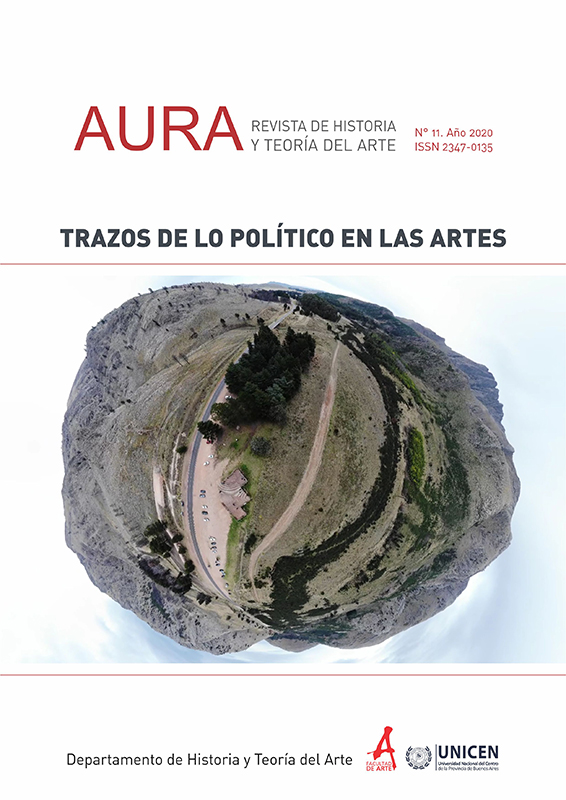Territoriality, locality and political drifts in Latin America: art criticism and artist writings
Keywords:
art criticism, artists’ writings, Latin America, decolonial theoryAbstract
This article analyzes a series of art criticism and artists’ writings, produced in Latin America between the 1960s and the beginning of the 21st century. Related to the work developed by the artists of the region, who reworked the hegemonic artistic postulates through art works that fused the contributions of the centers with local traditions and concerns, the texts of art criticism and also the artists’ writings questioned the colonial matrix of the modern artistic project and built new theoretical horizons to signify regional artistic practices.
The set of writings analyzed in this article, is organized based on two recurring problems in regional artistic thought: the question of territoriality and locality, and the desire for the construction of critical practices capable of resisting (or at least reconfiguring) the imperatives of western modernity and have an impact in the present.
References
Acha, J. (1978). "La actual división técnica del trabajo artístico en América Latina", Primer encuentro Iberoamericano de críticos de arte y artistas plásticos. Museo de Bellas Artes de Caracas, Venezuela, 18-27/06/1978. International Center for the Arts of the Americas at the Museum of Fine Arts, Houston, ICAA. Record ID: 815489.
Camnitzer, L. (1992). “Arts, Politics and The Evil Eye”, Third Text, 6:20, pp. 69-76.
_____. (2008). Didáctica de la Liberación. Arte Conceptualista Latinoamericano. Montevideo/Buenos Aires: Casa Editorial HUM, Centro Cultural de España.
_____. (2009). De la Coca-Cola al Arte Boludo. Santiago de Chile: Metales Pesados.
Castro Gómez, S. y E. Mendieta, eds. (1998). Teorías sin disciplina (latinoamericanismo, poscolonialidad y globalización en debate), México, Miguel Ángel Porrúa.
Gilman, C. (2012). Entre la pluma y el fusil. Debates y dilemas del escritor revolucionario en América Latina. Buenos Aires: Siglo XXI.
Greenberg, C. (1932). Letters to college friend Harold Lazarus, Jan-Sep 1932. Clement Greenberg Papers, 950085, Getty Research Institute, Special Collections, Los Ángeles.
_____. (s.f). “Aesthetics Considerations in Politics”, Clement Greenberg Papers, 950085, Box 26, Folder 13, Getty Research Institute, Special Collections, Los Ángeles.
Guilbaut, S. (1990). De Cómo Nueva York robó la idea del arte moderno, Madrid: Mondadori.
Longoni, A. (2007). “Otros inicios del conceptualismo (argentino y latinoamericano)”. https://www.dropbox.com/s/2h14vm9xi5u5htu/OtrosIniciosdelConceptualismo.pdf
Medina, C. (2006). “El último refugio del arielismo”. Ponencia presentada en Marta Traba y las batallas del arte en Latinoamérica, XI Cátedra Internacional de Arte Luis Ángel Arango, Bogotá.
_____. (2007), “Delays and Arrivals”, Curare 27, pp. 113-117.
_____. (2013). “Contemp(t)orary: Once tesis”, Revista de la Escuela de Arquitectura de la Universidad de Costa Rica, Vol. 2, pp. 1-11.
Mignolo, W. (2008) “La opción de-colonial: desprendimiento y apertura. Un manifiesto y un caso”, Tabula Rasa no. 8, pp. 243-281.
Mosquera, G. (1996). Beyond the Fantastic: Contemporary Art Criticism from Latin America. London: Cambridge.
_____. (1996b). “El arte latinoamericano deja de serlo”, Madrid, ARCO Latino.
_____. (1997) “Arte que va hacia afuera”, en Kurt Hollander (ed.) Así está la cosa. Instalación y arte objeto en América Latina, México, Centro Cultural Arte Contemporáneo.
_____. (2000). No es sólo lo que ves: pervirtiendo el minimalismo, Madrid: Centro de Arte Reina Sofía.
_____. (2010). Caminar con el Diablo. Textos sobre arte, internacionalismo y culturas. Madrid: Exit Publicaciones.
Oyarzún, P. ([1989] 2000). “Arte en Chile de veinte, treinta años”, Arte, visualidad e historia. Santiago de Chile: Ed. de la Blanca Montaña, https://www.academia.edu/682332/Arte_visualidad_e_historia
Pedrosa, M. (2017). De la naturaleza afectiva de la forma, Museo Nacional Centro de Arte Reina Sofía, Madrid.
(autora). (2016). “Lo político como condición de lo latinoamericano. Crítica de arte desde América Latina en los sesenta y setenta” en El Arte Latinoamericano durante la Guerra Fría: Figurativos vs Abstractos, Antonio E. de Pedro, coord. Nuevas Lecturas de Historia. Revista monográfica de la Maestría en Historia de la Universidad Pedagógica y Tecnológica de Colombia (UPTC), Suplemento No. 36.
(autora). (2019). Ruptura y continuidad. Crítica de arte desde América Latina, Santiago de Chile, Metales Pesados.
Richard, N. (2009). “Lo político en el arte: arte, política e instituciones”, E-misférica 6.2 Cultura + Derechos + Instituciones. https://hemisphericinstitute.org/en/emisferica-62/6-2-essays/lo-politico-en-el-arte-arte-politica-e-instituciones.html
_____. (2010). “Derivaciones periféricas en torno a lo intersticial”, en Cuauhtémoc Medina (ed.), sur, sur, sur, sur, Séptimo Simposio Internacional de Teoría sobre Arte Contemporáneo [SITAC], MEDINA, Cuauhtémoc, ed. México: Patronato de Arte Contemporáneo.
_____. (2013). Crítica y política. Santiago de Chile: Editorial Palinodia.
Speranza, G. (2012). Atlas portátil de América Latina. Arte y ficciones errantes, Barcelona, Anagrama.
_____. (2017). Cronografías. Arte y ficciones de un tiempo sin
tiempo. Barcelona, Anagrama.
_____. (2019). Futuro Presente. Perspectivas desde el arte y la política sobre la crisis ecológica y el mundo digital. Buenos Aires: Siglo XXI / Universidad Torcuato Di Tella.
Traba, M. ([1973] 2005). Dos décadas vulnerables en las artes plásticas latinoamericanas, 1950-1970, Buenos Aires, Siglo XXI.
_____. (1974). Mirar en Caracas. Crítica de Arte. Caracas: Monte Avila Editores C. A.


